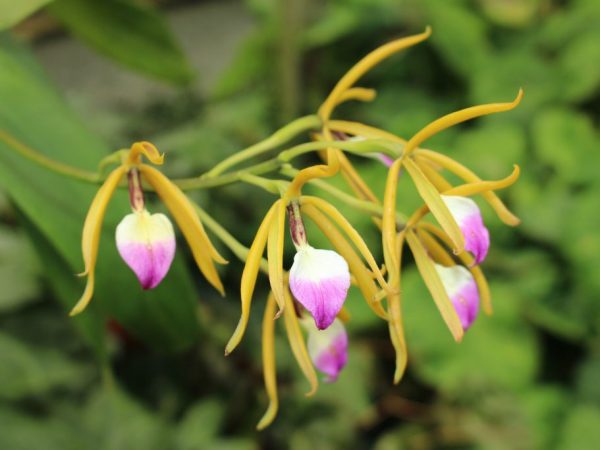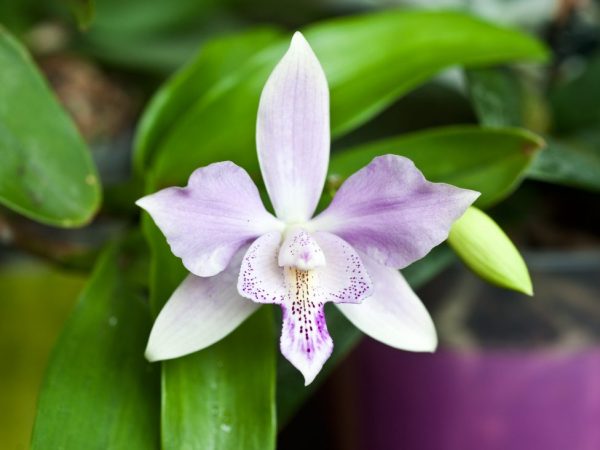Characteristics of the Brassavola orchid
The Brassavola Orchid is one of the most popular indoor plants. A lovely flower that can brighten any room. Now there are about 20 species of this indoor flower, each of them has its own characteristics.

Characteristics of the Brassavola orchid
Description of Brassavola
Dark green fleshy leaves, the length of which is 20 cm. The buds of the brassavola are located at the top of the stem. During flowering, no more than 5 flowers can appear on one peduncle. Orchid flowers do not fully open, they have green, sometimes yellow, and sometimes a little pinkish. Straight, pointed at the tips, Saintpaulia. A similar shape, but thinner and shorter - petals. The lip is wide, in some species it is framed with a fringe, resembles a heart in shape, its color is sometimes white with a pink speck.
Most of the known varieties of this flower are interspecific hybrids. They were obtained by crossing several types of orchids:
- Nodose;
- Kukulata;
- Nodular Brassavola.
The result is unusual indoor flowers. In most hybrids, it was Nodoza that was used, since it is unpretentious and it will not be difficult to grow it.
Growing
An orchid has the ability to grow both an experienced florist and a beginner. This process has no difficulties. Proper care will help it bloom at a young age, and bloom will continue for a long period.
Landing
Planting an indoor flower should start with choosing a place. The orchid should stand in a well-lit area of the room, but it should be borne in mind that the direct rays of the sun can burn the plant. The height of the pot in which the flower is placed must match the width of the neck. The volume of the container must be suitable for the size of the root system. Most often, a plastic or ceramic pot is chosen for these indoor flowers.
Growing by seeds
Germinating seeds is difficult. They have no nutritional reserves and need constant nourishment. The soil should be breathable, and crushed moss should act as a substrate for the flower.
The container for growing a plant from seeds should be glass; a flask for chemical experiments is best. It is important to sterilize the glassware and the seeds themselves before planting. The soil is prepared from charcoal and pine bark. After the seeds have been sown, they need to be exposed to the light for at least 12 hours, while the temperature should be 18-20 ° C.
Sprout growing
Most often, a flower sprout is located near its roots, it begins to grow after the flowering period. After the shoot has been cut off, it is wrapped in wet moss so that the shoot can take root. A pot for transplanting is also prepared. Stones or pebbles are placed at the bottom, they should make up 1/3 of the total volume of the pot. We place the shoot in the middle and gradually fill the container with soil.
Flower care

Beautiful whimsical flower
Care after planting should be thrifty, you need to water the flower at least after 2-3 days. At first, growth stimulants are added to the water.
After 3 years, an adult plant will be formed. For orchids, special fertilizers are used, which can be purchased at a specialized store. Fertilize the plant every 3-4 weeks.
Foliar dressing is also relevant, the flower is sprayed with a weak nutrient solution. Pruning is carried out only if necessary if the pseudobulb is completely dry. A transplant is carried out if the root system does not fit into the container in which the plant was located.
The flower needs high humidity and therefore watering should be regular. But you need to water it after its substrate has dried. It is also advised to place the pot in a bowl of water and sprinkle it with hot water from a shower, about 40 ° C. After the flowering period, dormancy occurs and at this time watering should be reduced.
The flower needs good lighting, but don't place it close to batteries. Temperature changes are necessary for the development of flower buds. The flower is thermophilic and will feel good in winter if the temperature does not drop below 18 ° C during the day and 12 ° C at night. In summer, it withstands high temperatures, up to 35 ° C.
Diseases and pests
By the state of the leaves, it is possible to determine what the flower is sick with:
- The appearance of yellow spots on the leaves is a disease of powdery mildew, fusarium rot or pest: spider mite, whitefly, red flat mite.
- Leaf lethargy - bacterial spotting or pests: aphids, spider mites.
- The appearance of sticky spots is bacterial spotting or aphids.
- The leaves are covered with a sticky white coating - powdery mildew, bacterial spot or aphids.
- Leaves rot - Fusarium rot.
- White dots on the leaves - powdery mildew, pest: mealybug, spider mite, thrips.
- Black spots on the leaves are black rot or spider mites.
Fight disease
Basically, flower diseases are associated with rotting. And viral or fungal diseases can arise from an infected substrate.
If the indoor flower has rotted, then the damaged areas must be cut off, then treated with Bordeaux liquid and sprinkled with coal dust. The substrate is discarded after sterilizing the pots. In the fight against fungal diseases, soaking the orchid in a solution of colloidal sulfur will help. Viral diseases are not cured.
Pest control
If the flower is infected with a pest, it must be isolated from other plants. In the fight against pests, chemical agents (phytoverin, a solution of laundry soap, actellic) and disinfection of pots and substrates with coal dust will help.
Prophylaxis
The best prevention for orchids will be the highest quality care. The irrigation regime, temperature regime and control of the state of the substrate must be observed. Also, as a preventive measure, you can treat the plant with a Fundazole solution. But the substance is toxic and you should not overdo it with it. Periodic spraying with Fitosperin will also save the flower in a timely manner. The leaves should be washed regularly, dried out areas should be removed.
Conclusion
Brassavola is one of the most beautiful and popular plants. It decorates the house with its appearance and aroma. Such a delicate flower needs constant care and watering. But even an inexperienced florist will be able to grow it, so with careful care, this indoor flower will survive in any home.


